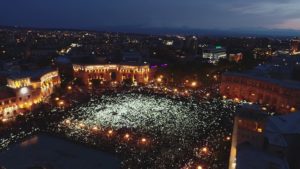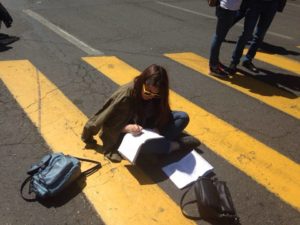Minds of the Movement
An ICNC blog on the people and power of civil resistance
by Lilit MakuntsMay 10, 2018
Before April 23rd, it seemed impossible to stop Serzh Sargsyan, Armenia’s president of 10 years, from becoming a lifetime prime minister. But thanks to the pressure of continuous mass protests—first in the capital of Yerevan then throughout the country leading up to this historic date—Prime Minister Sargsyan resigned, after being in office for only six days.
This was only the first phase of people power for political change in Armenia. The second phase came a few days after Sargsyan’s resignation, when the ruling Republican party attempted to block movement leader, MP Nikol Pashinyan’s bid for prime minister—a move communicating that the Republican Party wanted to keep its grip on power. Upon Pashinyan’s call for a general strike on May 2nd, more than 200,000 people engaged in strikes, blockades, and other nonviolent actions throughout the country, for the opposition candidate to be appointed. On May 8th, Pashinyan was elected the new prime minister, with 59 votes in favor of his candidacy and 41 against.
At this very moment, people throughout the country are celebrating the long-awaited yet miraculously short (mobilization lasting only 33 days total) victory over the ruling party’s attempt to undermine democracy. But it is important to note that this was achieved through smart strategic choices based on lessons learned from the past.
It’s also important to note that a third phase of mobilization is now to give Pashinyan leverage over the majority in Parliament held by the oligarchs, in order to pave the road to Parliamentary elections. If Pashinyan is consistent with the promises he made as he took office, he will indeed continue to have the mobilized support of the people, including the grassroots.
How Did Armenia’s Velvet Revolution Start?
As a result of the constitutional referendum in 2015, Armenia shifted from a presidential to a parliamentary system with the prime minister being the key political figure in the country. The people of Armenia apprehended this move as nothing other than an obvious bid to prolong ruling party power for another 10 or 20 years.
Just days before the election of the prime minister in April of this year, a peaceful movement escalated, led by MP Nikol Pashinyan. With his team of about 20 people from the Civil Contract Party, Pashinyan launched the initiative “My Step” in Gyumri (the second major town in Armenia) on March 31st. It initially planned to organize a march in the major towns of Armenia for 14 days and then hold demonstrations in the capital for the four days leading up to the election.
At the same time, another grassroots initiative “Reject Serzh” started organizing separate protests in Yerevan with a few dozen people publicly collecting money for Serzh Sargsyan’s retirement (a nod to Serbia's movement Otpor’s humorous nonviolent tactic preceding the downfall of long-time President Slobodan Milosevic at the turn of the 21st century).
On April 13th, “My Step” entered Yerevan and united with “Reject Serzh” under the slogan “Take a Step, Reject Serzh.” Soon, they blocked the intersection of two major avenues (French Square) and paralyzed an important part of downtown Yerevan. This helped them gain attention and attract more protesters for the mobilization. Within two days they managed to organize a demonstration in the Republic Square with tens of thousands of people.
On April 17th, Nikol Pashinyan dubbed the mobilization the Velvet Revolution—a name chosen to imply that it would be peaceful and nonviolent. Many people associate this name with the Velvet Revolution in Czechoslovakia, which put an end to the Communist one-party regime in the country.
Nonviolent Discipline and Other Notable Strategic Choices
Apparently, the ruling Republican party and Serzh Sargsyan underestimated the strategic capacity of the movement. They didn’t expect the seemingly “innocent” protests to turn into large-scale nonviolent mobilization and create a deadlock situation for the government.
One of the crucial movement strategies was excluding any kind of regional politics in their discourse and avoiding any involvement of “big brothers” (northern, eastern or western supporters such as Russia, the United States, or the European Union). It is widely believed that this has been the most influential strategic choice for gaining legitimacy and leveraging people power.
Another fundamental strategic choice has been a very public commitment to and call for nonviolent discipline. Movement leaders announced early on that any person not complying with the rules of nonviolent discipline was external to the movement and could not be associated with it in any way. This clear-cut division has helped downplay fake propaganda that many had been anticipating from the government and its allies to manipulate public opinion.
Propaganda attempts have failed not only due to the movement’s calls for nonviolent discipline among its supporters, but also joint efforts of journalists to report on developments in strategic ways that helped the movement gain legitimacy and grow. Authorities’ counter-reactions to the mobilizing were characterized as a “poorly staged soap opera” and attracted even more people to join the movement.
One unique characteristic of Armenia’s Velvet Revolution was that activists did not spend the night on the streets protesting. They organized mass protests during the day, and at 10 p.m., everyone was required to go home to rest and be ready to protest again the next day. In doing this, organizers applied lessons learned from past movements that had experienced police repression particularly during street actions at night.
As professor at Yerevan State University, Serob Khachatryan notes, past demonstrations in Armenia engaged in one-way “lecturing” and top-down instruction. This year’s movement broke away from this practice: every day, organizers assigned activists preparatory tasks to complete by the next day, such as blocking the streets with big trucks and boycotting supermarkets owned by oligarch MPs. These tasks helped generate a sense of buy-in among movement participants, who saw the direct impacts of their actions on a daily basis.
What Else Was Different with Armenia’s Velvet Revolution?
The 2018 Velvet Revolution was different from what the people of Armenia had seen before. All of the districts of Yerevan and almost all the communities of Armenia organized local peaceful protests, blocking, paralyzing cities, towns, and villages, interstate roads, the metro, and the airport. A general strike and other nonviolent actions took place all over Armenia. People organized flashmobs to bang pans from their windows and balconies at an arranged time in all the districts of Yerevan. Streets were blocked by people singing, playing musical instruments, playing chess or other games, and barbers cutting hair. And all of this exclusively with underlying messages of love, kindness, and care for the country (symbolized by activists cleaning the squares after protests).
The 2018 Velvet Revolution also drew on abundant sources of creativity, innovation, and inclusiveness. The atmosphere of love exceeded the beautiful vibes of Electric Yerevan (a popular mobilization in June 2015 to protest the planned hikes in electricity tariffs). It escalated due to the spontaneous engagement of a large number of students and young people who started strikes at schools and workplaces. The element of surprise, and diversity in nonviolent tactics were key to the movement’s success, as was the leadership’s transparency and inclusive approach to building the movement. On that note, observing that young women played an essential role during the protests, Pashinyan even stated publicly that the driving force of the protests were women and their exceptional engagement in the process.
Looking into the Future: What’s Next?
Armenia’s Velvet Revolution is already an established fact in this country. Before the movement’s short-term success, the streets of Yerevan had not seen so many smiling faces for a long time. The country gained new colors and vibes in the space of less than a month. The revolution took place not only in the form of a transition of power but also in the minds of the people.
At the same time, it should be acknowledged that there is still tremendous work to be done in all sectors of the country during this period of political transition. The new cabinet is going to be formed within the next 15 days. It will be a major challenge for the cabinet to promote changes with a minority government (the Republican Party is still the majority in the Parliament).
We know it is going to take time and a great deal of effort to re-establish the country we cherish. But we are ready to face these challenges with revolutionized minds and a solid foundation for bringing this dream to reality.

Lilit Makunts
Since May 2018, Lilit Makunts serves as Minister of Culture of Armenia. Previously, she was an Associate Professor at the Russian-Armenian University in Yerevan. Since June 2012, she has been fostering civic awareness both in Yerevan and rural areas of Armenia. She is an ICNC Curriculum Fellow (2016-17) and ICNC Summer Institute alumna (2015).
Read More


